#pirates in africa
Text
youtube
Modern Pirates of the African Coast
"Okay, what do you do with this money?"
-
"The money? I use to buy ammunition and speed boats, and the rest to take care of our families. Because we do our jobs. That is why we are doing this dirty job."
"You come to exploit here and don't want to employ me. That is why, that is the major reason why we are doing this. You don't want to employ us and you are exploiting from us."
-
I find this very sad. These people have ZERO prospects for their future from the moment they were born. Their country has been used, abused and had the wealth sucked out of it over the last 4 centuries, continues to be exploited to the extreme and they grow up in harder circumstances than Westerners could ever fathom. They take from this a lesson: their lives are meaningless to the powers-that-be and if they want any shot at wealth or security, then they must fight to the death to take it.
Is it really surprising then that some of these men with no future and no security turn to kidnapping, smuggling and extortion to give their lives some meaning?
#africa exploitation#african pirates#pirates in africa#us imperialism#western colonialism#western imperialism#imperialism#colonialism#neocolonialism#us hegemony#worker exploitation#socialism#communism#marxism leninism#socialist politics#socialist worker#socialist news#socialist#communist#marxism#marxist leninist#progressive politics#politics#workersolidarity#worker solidarity#exploiting africa#Youtube
37 notes
·
View notes
Text
Much attention and condemnation has been directed towards the tragedy of the #African slave trade , which took place between the 16th and the 19th centuries.
40 notes
·
View notes
Text
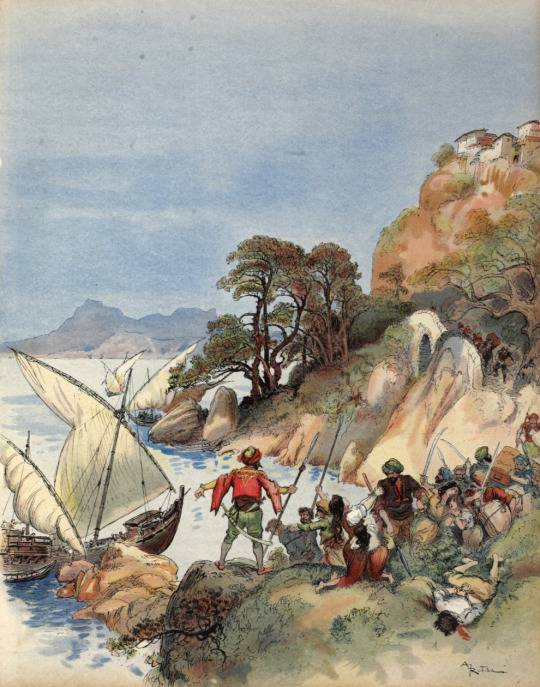
Barbary pirates terrorising the coast of the Mediterranean, kidnapping the inhabitants to sell as slaves
by Albert Robida
#barbary pirates#mediterranean#art#albert robida#pirates#pirate#europe#southern europe#barbary coast#north africa#history#european#north african#berber#berbers#muslim#muslims#islam#islamic#corsair#corsairs#ottoman#ottomans#ottoman empire#illustration#georges g toudouze#georges gustave toudouze#christians#christian
34 notes
·
View notes
Text
"I remain entranced by its utter inability to provide for itself," Dalila marveled. "Tinbu must hand-feed it so that it does not starve. The only thing it does seek to consume on its own initiative is my black powder. It is such a failure of a cat that I cannot help but be impressed."
#shay speaks#the adventures of amina al sirafi#this is how some of you talk about your blorbos and i think its funny#im like 185 pages into this book now. maybe 40% of the way through#but its really good id recommend it if you like fantasy and pirates#it takes place in the middle east and east africa mostly rn like along the indian ocean#amina top tier main character she is so good and very very funny
24 notes
·
View notes
Text
i present to you: the great tpof fancast


Christophe-Julien de Rapièr : Romain Duris, Molière (2007)


Esmeralda Maria Consuela Anna de Sevilla: Salma Hayek, Fools Rush In (1997) / The Hunchback of Notre Dame (1997)
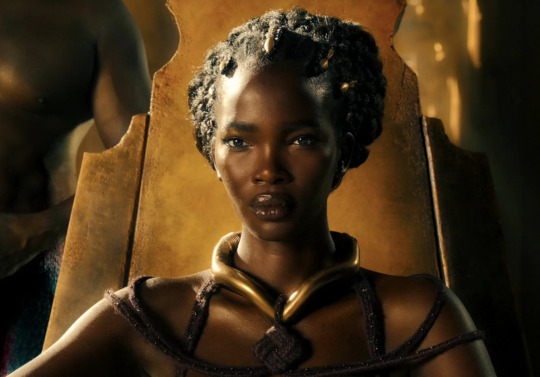
Princess Amenirdis : Aamito Lagum, Three Thousand Years of Longing (2022)

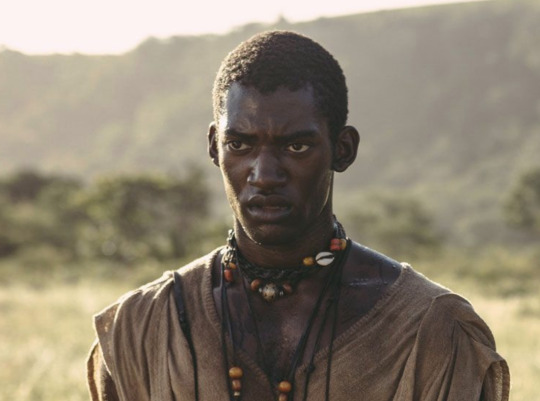
Prince Shabako: Malachi Kirby, Roots (2016)

Pharaoh Taharka : Idris Elba, Thor: Ragnarok (2017)

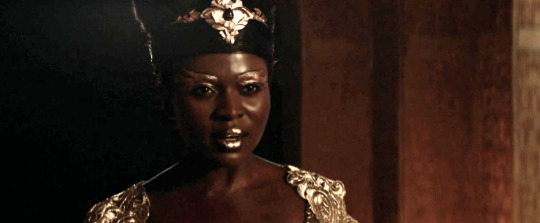
Queen Tiyy: Yetide Badaki, American Gods (2017-2021)
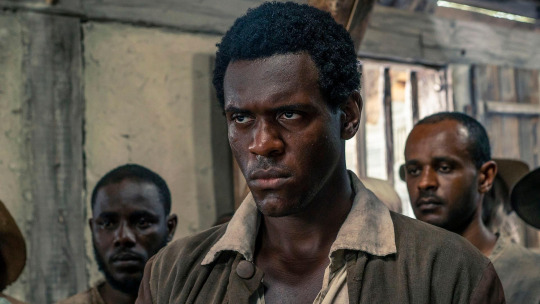
Tarek: Abubakar Salim, Jamestown (2017)
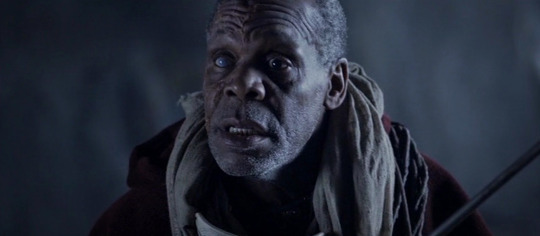
Piye: Danny Glover, Age of the Dragons (2011)

Chamba: Paulo Andre Aragao, The Lost Pirate Kingdom (2021)

Lord Reginald Marmaduke Bracegirdle-Penwallow: Charles Dance, The Great Fire (2014)

Don Rafael : Edward James Olmos, Monday Nights at Seven (2016)
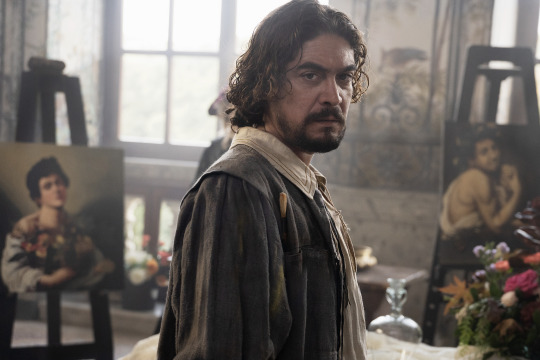
Luis Montoya : Riccardo Scamarcio, Caravaggio’s Shadow (2022)
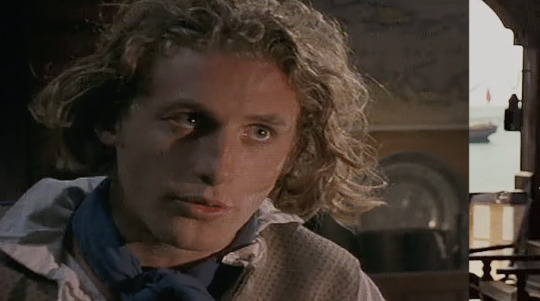
Robby Greene: Dean O'Gorman, Return to Treasure Island (1996)



The Becketts. Jonathan Jr.: Luke Roberts, Black Sails (2014), Bartholomew : Tom Felton, Belle (2013), Jonathan Beckett: Michael McElhatton, Dangerous Liaisons (2022)

Cutler Beckett: Jonny Lee Miller, Plunkett & Macleane (1999)

Jane Beckett: Sarah Gadon, Belle (2013)

Ian Mercer: Sebastian Armesto, Harlots (2017)
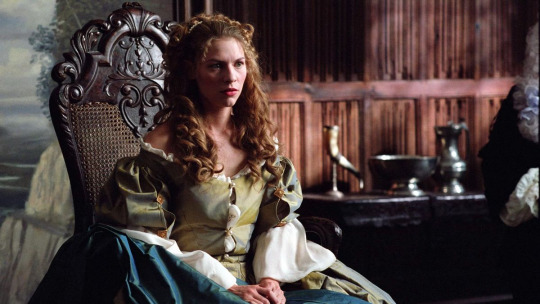
Melinda: Clare Danes, Stage Beauty (2004)
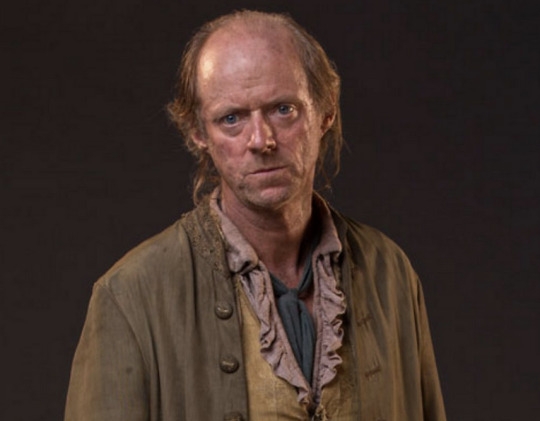
Boris Palachnik : Ned Dennehy, Banished (2015)

Frank Connery : Tristan Sturrock, Poldark (2015)
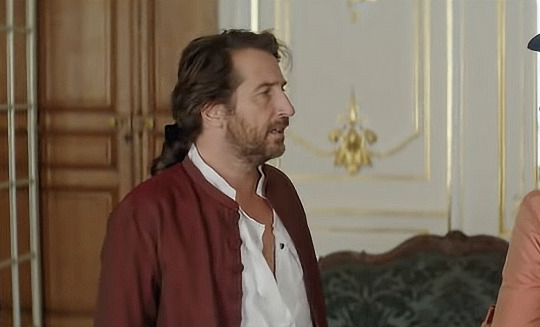
Etienne de Ver: Edouard Baer, Lady J (2018)

Lucius Featherstone: Henry Douthwaite, Wuthering Heights (2018)

Steve Seymour : Dean Lennox Kelly, Jamestown (2017)

Marie Seymour : Astrid Bergès-Frisbey, Bruc (2017)

Jack : Johnny Depp, The Man Who Cried (2001)
bonus section:

Sean Bean as a young pirate Bootstrap Bill, Lorna Doone (1990)
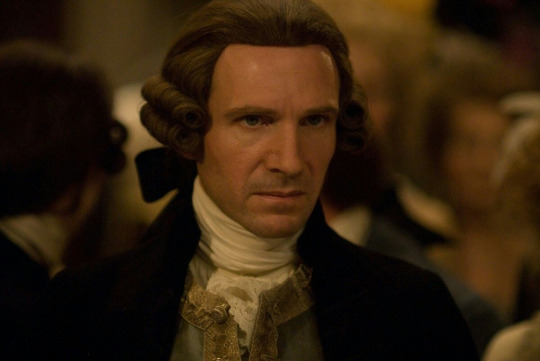
Lawrence Norrington as Ralph Fiennes in The Duchess (2008)
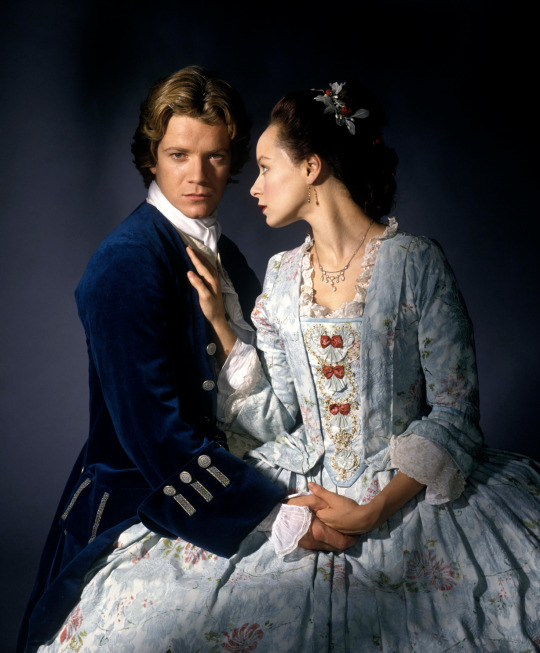

Fitzwilliam P. Dalton III: Max Beesley, The History of Tom Jones, a Foundling (1997)

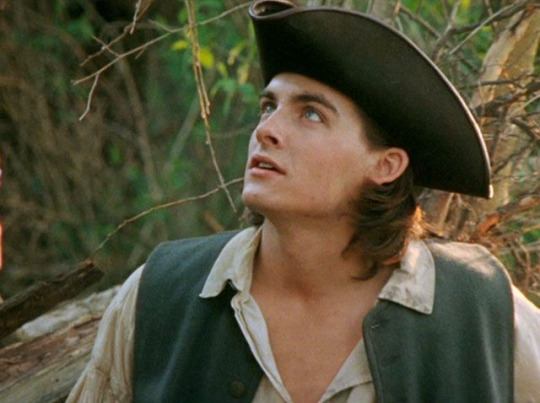
Tiny James Norrington : Keven Zegers, Treasure Island (1999). Slightly larger James Norrington: Keven Zegers, Felicity: An American Girl Adventure (2005)
#things i have learned during this experience: there rlly is an obscure period drama for EVERYTHING#pirates of the caribbean#the price of freedom#potc#some of these i am genuinely SO happy about !!!!!!#like. christophe beckett and bootstrap .... WIN#i would love to have found period pieces about ancient egypt / kush / northeast africa in general with woc instead of white women#im sure they are out there but english search terms didn't yield me anything#if anyone has recs i am accepting. but face-wise im pretty satisfied with the family resemblance for the zezurans
66 notes
·
View notes
Text
youtube
#gonna need to learn how to pirate again because I refuse to pay for Netflix again#Netflix#Youtube#also did anyone watch the Wrestlers show on Vice with my boy Damian?#that show was sick because he went to wrestling from all over the world#even Africa!#maybe I’ll make a master post here if I can find all the episodes
3 notes
·
View notes
Text
The most powerful fleet the world has ever seen with total sovereignty of the seas
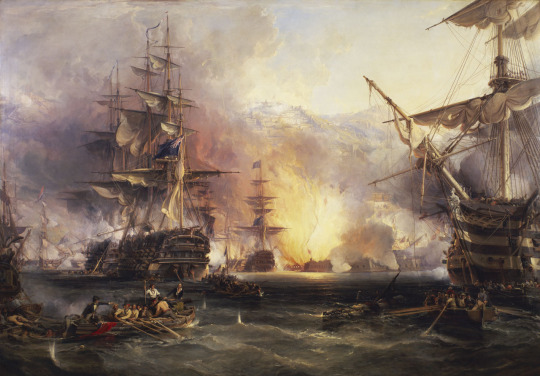
Bombardment of Algiers
This huge country, the largest in Africa, has a secret few people know of, embedded in its history. But this mystery is about to be revealed.
The forestal resources
Even though this enormous nation consists mostly of desert (80%), Algeria is much more than meets the eye! The Sahara is made up mostly of plateaus and sand dunes, and it is predominantly found in the southern parts.
The north west is composed of mountain elevations, meanwhile the north east also has massive mountains, plains and basins. It differs from the western parts in the sense that its basic topographic features do not equal the coastline.
Its long ridges, steep cliffs and huge mountains create an almost impenetrable refuge that has played an utmost important role throughout the country’s history, ever since Roman times.

Desert of Algeria, in the southern parts of the country.
It is the northern mountainous regions that are responsible for rainfalls that in turn causes seasonal rivers rising in the mountains bringing alluvial soil rich in minerals, thus extremely fertile, especially to the Tell the country’s heartland, an area made up of hills and fertile plains surrounding the narrow coastline.
It is here that we find most of the Algerian forest reserves. In ancient times a dense forest grew on these plains, inundated with wild beasts and reptiles, a perfect site for ship construction, because of the abundance of wood and proximity to the sea. Here is where the Algerian fleet was born!
This great nation can be described as a mosaic, where every historical event represents a small piece in the gigantic mosaic picture, and it is first when the pieces are joined together you understand the whole picture.
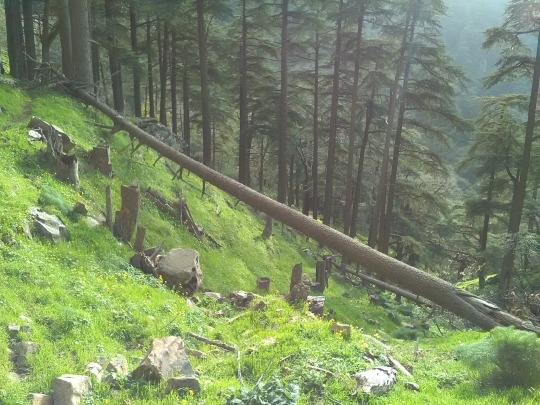
Wonder wood of Algeria
Algeria’s history of mosaic
Algeria has a colourful national history even though during the periods of the great Empires their influences dominated the history of the entire region, but during the times in between these great powers Algeria’s own history got a chance to prosper.
The Phoenician’s, an ancient civilization originating in the Levant region, located in modern day Lebanon, arrived on the North African coast around 900 BC where they established Carthage, in present day Tunisia around 800 BC. During this “classical” period the Algerian tribes lived on agriculture, manufacturing and trade.
Trade links between them and Carthage were intense and strong, something that made Algeria prosper both economically and technologically.
Carthage soon became a significant shipyard, the Algerians' close relationship with them resulted in mutual cooperation and eventually Algeria also developed a refined naval construction base from which it would later launch a naval power.
The similar geographical conditions and shared knowledge showed to be beneficial for both nations.
The dense forested areas, identical in both countries, consisted principally of pine and cedar wood trees, something that proved to be extremely useful in naval construction.
In that time every single ship was especially constructed to sail in a specific sea or maritime location. The sea in which the ship was supposed to sail decided the kind of wood, method and model that would be needed for its production.
Ships sailing in the Mediterranean area or the so-called “Mediterranean ships” were generally built with cedar wood or pine whilst linen was used in making ropes. These ships were painted with tar or bitumen.

An Algerian ship off a Barbary port
With the fall of the Carthaginian Empire and the arrival of the Romans new methods and advancements were adopted and further improved upon.
Even though the relation between the Algerians and the Romans were described as “stormy” , they brought reform and new knowledge in ship construction as well as improvements in the urbanisation of the country.
Later in the dawn of the Arabs and Islam 670-711 A.D., during the Umayyad dynasty, a diverse and further reformed method of ship construction was developed, something that further improved and refined the already existing highly developed naval construction techniques.
There is no doubt that this long chain of different influences from various countries and Empires and their different experiences, knowledge and techniques made up a solid base for ship construction. This basic knowledge was later improved, refined and perfected upon for an extended period of time , until a perfectly sophisticated and advanced Algerian ship making was developed, so refined that Algeria became the leading naval construction nation in the world.
Mission impossible
But it was not only the Algerians that possessed a large fleet, the Caliphate of the Ottomans had an impressive and well organised fleet as well.
This Islamic naval force was of utmost importance to the entire Caliphate yet it was still to expand considerably both in size and knowledge wise.The Caliphate asked for the cooperation from the powerful Algerian fleet early on, for mutual benefit throughout much of the fleet’s existence, an agreement forming an alliance, companionship and for mutual support.
Furthermore it was of essential importance to have experienced and well educated admirals and leaders in charge of the fleet, thankfully they existed in abundance. One of these great admirals was a man whose story we will learn about now.
The story begins with that Barbarossa or Admiral “Arrouj”, as was his real name, a European Muslim Navy Admiral whose roots go back to Albania, was assumed to a meeting with Sultan Selim I , and the Great Navy Commander of the Ottoman fleet, due to messages of desperate appeals sent from people in al Andalus (Spain during Moorish rule) to save their friends and family from the dark basements of torture where they were held prisoners.
The Sultan assigned Arrouj to a mission that today would be called “mission impossible” and gave him the strategic guidance to the mission.

Arrouj Barbarossa
To sum up the mission Admiral Arrouj was to sail from the far east of the Mediterranean in today’s Turkey to the far west in Andalusia, through all existing threats, then to anchor safely in one of the Andalusian cities, now under Christian rule, destroy the naval Spanish protectorate of that city through a surprise attack.
The surprise attack was an important strategy in order to discover the location of the torture basements. Having discovered the secret locations, they had to free the prisoners, Mozarabs (Spanish converts), Jews and others from the basements, after sunset.
The reason for the specific timing was to avoid the prisoners getting blinded by the sunlight, as a result of being captivated during years in darkness.
Finally they had to sail: by night, not to Turkey but to Algeria, taking an alternative route, in order to transport the prisoners in the fastest time possible on one hand, and to simultaneously lure the navy of the enemy on the other hand. End of mission!
The mission was more than impossible, however, the big surprise was that the Navy Commander carried out the mission with outstanding success!
What is even more surprising is that his brother repeated the same mission numerous times, together they saved tens of thousands of original Spanish Muslim converts, Jews and even Protestant Christians ( mostly English sailors taken hostages by piracy or in sea battles) from torture and death.

Ghosrof Barbarossa
The reputation of the brothers Arrouj and Ghosrof spread throughout the seas of the world, and the streets of the Catholic Europe scattered stories started to spread of the heroism of an Ottoman sailor, who sails like a horrific ghost that no one can stop.
The deliberated prisoners called him Baba Arrouj or Baba Arrouts (father Arrouts) out of their utmost respect and gratitude to him, who saved them from the horrors of the inquisition, this in turn led to the Italians distortion of his name to Barbarossa, Italian for red beard.
The great naval commander Arrouj defended the coasts of Algeria for a long time but was caught by the Spaniards, and brought to Spain where he was executed, and as “this” was not enough they cut off his head and paraded it throughout the city.

A sea fight with the Berber fleet
His brother Ghosrof, nicknamed “Khairiddine”, (meaning “the good” of the religion) from the ever gratefully prisoners he saved from al Andalus.
Khairiddine took his brother’s place and continued to fight for what was right. He sailed to Tunisia where the Spaniards and Portuguese were trying to invade the country, he destroyed their ships and liberated Tunisia and Algeria.
The Catholic world was now infuriated and gathered a coalition fleet, named “the Holy League” consisting of many different nations*, altogether 600 ships and 60.000 soldiers led by Europe's greatest naval commander at the time, Andrea Doria, facing the joined Caliphate’s and Algerian fleet under the commander Admiral Khairiddine Barbarossa and his 122 ships and 22.000 soldiers.
*The coalition fleet, the Holy League, consisted of the Papal state, Habsburg, Spain,Republic of Genoa, Republic of Venice and the knights of Malta.
They met in the battle of “Preveza” on the 28th of September 1538 AD. One of the greatest naval battles in history. Despite the fact that the coalition fleet outnumbered the Muslims in men, ammunition and ships,
Khairiddine Barbarossa, commander of the Ottoman Caliphate won the battle. It was a total victory, the European fleet was completely destroyed, and Andrea Doria ran away from the battle site, the battle that didn’t last more than five hours.
After this great victory, a state of fear and panic spread throughout the enemies' princedoms and the combined Algerian and Ottomans Islamic Navy became the master of the Mediterranean Sea for three centuries to come, without rival.
The family Piri Reis

Piri’s Map of central and south America.
After the victory of Khairiddine Barbarossa, the Naval fleets of the gigantic Ottoman Empire became the greatest naval power of the seas and oceans.
The two brothers Barbarossa were students and taught all the secrets of the sea by a man called Kemal Piri Reís, al reís is Arabic for head, meaning head of the ship or captain.
Al Reís is Arabic for head, as in head of the ship or captain.
He was also a teacher to his own nephew: Ahmed Mohedeen Piri, and gave him an excellent education.
Kemal Piri Reís, joined the brothers Barbarossa on many of their journeys including the once to al Andalus to free the prisoners, he was well experienced and a great support for the brothers in their missions.
Kemal Reís’s nephew was more interested in drawing maps than anything else, he later became one of the best and most famous cartographers in the world. He always stayed close to his uncle and joined him on most of his missions.
Together they all rescued the prisoners in al Andalus, stood by and assisted the Mamluks in Egypt in their struggle against Portuguese colonisation as well as many other missions, and battles as in 1499 during the battle of Zonkuyl where Kemal Reís used cannons aboard his ship for the very first time in history, surprising his enemies, and winning the battle.
Eleven years later in 1510 a storm broke out at sea and the ship that carried Kemal Reís capsized and sank, resulting in the then 60 years old Captain Kemal losing his life, after a lifetime long of service to the caliphate’s fleet and people in need.
Nevertheless, after his uncle's death Ahmed Mohedeen Piri Reís continued sailing with the ships at sea.He drew the first ever map of the American continent. This map shows, and is the ultimate proof that the Americas were both discovered and mapped, long before Christofer Columbus discovered the so-called new world.
However, Piri Reís was not the first one either to discover these lands, the Africans, Arabs and Andalusians had been travelling for quite a while to both south and North America by then. But Piri Reís maps are, unlike other historical accounts that can be denied, not only solid proof that he was there before Columbus but he had also drawn detailed maps of the entire continent.
The maps were an accurate and very detailed picture of what he saw and experienced, he also wrote a book in where he explained his travels *. He later drew a map of the Antarctic, also this one in detail.
*Piri Reis book with detailed descriptions of what he saw: Kitabi Bahrisi (1521-1525).
In 1929 historians found a map on a piece of gazelle skin, and traced the map back to a 16 th century Turkish Admiral named: Piri Reis.
But contrary to other maps, from that time period, this one showed the exact coast of Antarctica as it exists today under the ice-cover, an amazing accomplishment because it meant that it was drawn in a time when Antarctica was ice-free. The map also accurately shows the coast of Europe and Africa but as already said it is the coast of Antarctica that stands out, as this region remained undiscovered for at least 300 years.
Moreover, when cartographers superimposed Piri Reis’s map over a modern day map they were astonished to discover that it was fantastically accurate in the most minute of details. It also included flora and fauna, everything where it belonged.
It was not only the oldest map showing the two Americas, the South Pole, Europe, Africa and Asia but it was so surprisingly accurate, that even the distances between the continents were remarkably precise.
Summary

Constantine, Algeria.
The longest lived and most powerful fleet in the world is the 300 years old prominent Algerian maritime fleet. At the time the greatest powers in the world were represented by the Ottoman Caliphate followed by England and France then the rising stars: Spain and Portugal, built on the ruins of al Andalus.
It was the events preceding the expansion of the Algerian fleet that also became the reason for its absolute sovereignty, and these historical events took place in Spain. It all began with the inquisition, When the Muslims and Jews were exiled from al Andalus (Spain) they brought the news with them of the poor conditions inside the country and the horrific torture that went on inside the basements.
The news spread as fire all over the Mediterranean, this in turn resulted in an urgent response for rescuing the prisoners, which brought the joint Ottoman Caliphate and the Algerian fleets to extremes.
As an answer to this rescue missions the pope gave his blessings to Spain and Portugal to establish a crusade, to Christianize North Africa and more important move the battles within Spain into Muslim territories, from defence in Spain to offence in North Africa. The Spaniards and the Pope Paul III, formed a coalition fleet together with several other countries, as earlier mentioned * see end article.
In the battle of Preveza the Algerian fleet totally defeated the opponents, this radical defeat was maybe the real turning point, it gave the Algerian fleet indisputable power, total respect and put fear into their enemies for a long, long time to come.
This is what made the fleet invincible and gave them total sovereignty in the world. Now they had to put order in the Mediterranean that had long been a breeding ground for European piracy. Random attacks on North African coasts and ships, fierce, unpredictable pirate attacks in between the Europeans themselves and others as well, caused lawlessness in the whole region and threatened to destabilise the trade in the entire Mediterranean.
The Algerian fleet stepped up and started to repel the European aggression, protecting trade and battling pirate operations.
New arrangements were imposed, the Algerian fleet in agreement with the Ottoman Empire, requested travelling ships in the area to pay a fee, a monetary payment to the Algerian fleet, in turn the fleet would guarantee the ships safety and be fully responsible for its protection as long as it remained in Mediterranean territory.
The Algerian fleet was responsible for all ships in the Mediterranean area (and other territories later on) anyone engaging in piracy was dealt with, hard handedly, any ship that didn’t pay their fee or disrespected the rules was not allowed to sail in the region.
In the beginning incidents and confrontations occurred but with time everything changed, everyone started to follow the rules. The powerful Algerian fleet succeeded in obtaining cosmos from chaos and bringing safety and security in the region, their protection was rarely needed anymore, they had completely rooted out European piracy!
But the most powerful naval fleet in history, in terms of length of time as well as power and control, their 300 years of golden rule and glory saw its end with the battle of Navarino 1827.
After many great and honourable deeds, the fleet retired, but Algeria remains a country with a flourishing mosaic and deep, honourable history roots, a history worthy of being written in gold!

Algerian Landscape
Interesting facts:
Algeria was the first country in the world to officially recognise the French Revolution.
Algeria helped France by lending them money and providing food during times of great famines. In the beginning of the 18th century France had an enormous debt to Algeria. The French being ungrateful, hungry for revenge due to the Algerians serving as a powerful naval base as well as helping the Caliphate in their naval struggles and lending their support to the Ottoman Empire, the French wanted revenge and added to that, being unable to repay the Algerians they went on to colonise the nation.
Algeria was attacked and conquered by the French the same year its fleet was dissolved 1827, the conquest was followed by plunder and mass killings, to the extent that Algeria is known in the Arab world as “the country of a million martyrs”.
One of the first countries in the world to recognise the United States as independent, was also Algeria.
It was believed, in Europe, until 1507 that those lands visited by Columbus were part of Asia and not a new continent.
The map of Piri Reis was depicted on the reverse of the Turkish 10 million lira (1999-2005) and on the new 10 lira banknote of (2005-2009).
#history#writers on tumblr#writblr#writers#original content#travel#algeria#north africa#berbers#berber#tunisia#fleet#algerian fleet#naval fleet#naval history#barbarossa#pirates#pirate ship#pirates of carrabean#map#map making
11 notes
·
View notes
Text
Principality of Sealand
O príncipe Michael de Sealand é líder de uma micronação chamada Principado de Sealand. Mike MacEacheran – BBC Travel. 14 set 2020
Localizado no Canal da Mancha, entre a ilha da Grã-Bretanha e o continente Europeu com incríveis 0,055 km², a plataforma está fora dos domínios territoriais da França, o que faz de sua localização uma “terra de ninguém”. Parque da Ciência Newton Freire Maia –…

View On WordPress
#1942 HM Fort Roughs#a plataforma de guerra que virou o menor país do mundo#Africa#americano Jeremiah Heaton#armed invasion#Barão ou Baronesa#Canal da Mancha#continente Europeu#controle do posto avançado#Convenção de Montevidéu#costa inglesa de Suffolk#criadores do website The Pirate Bay#critérios principais para a condição de Estado#E Mare Libertas (From the Sea Freedom)#estações offshore ilegais#ex-major do Exército britânico#ex-major do Exército britânico pescador#ex-major do Exército de Libertação do Povo Chinês#família#forte marítimo armado#forte naval abandonado#gesto romântico aniversário de sua esposa Joan#governo do Reino Unido#governo e relações com outros Estados#ilha da Grã-Bretanha#ilha da Grã-Bretanha e o continente Europeu#Lady#largo da costa Knock John#líder micronação#líderes internacionais
0 notes
Link
Digital art available.
#artforsale#artbuyers#artcollector#art#digitalart#digitalartist#skull#skullart#pirate#mysticalart#bones#kobart#kob#adinkra#africa#african#africanartist#africandigitalartist#wallart#interiordesign#books#2d#2dart#2dartist#digitalpainting
0 notes
Text
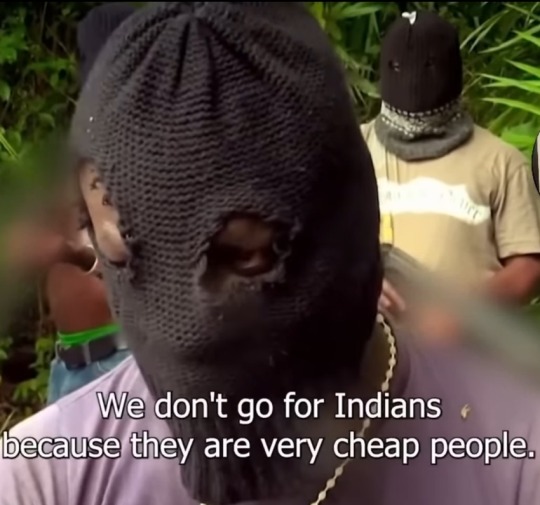
Nigerian Pirate
Black Devil
#photography#journalism#piracy#pirates#africa#nigeria#oilcompanies#abuse survivor#why is it so difficult#bless him#bless these people#love#peace#agip#journal#expedition#jungle#world news#unreality#dystopia
0 notes
Photo
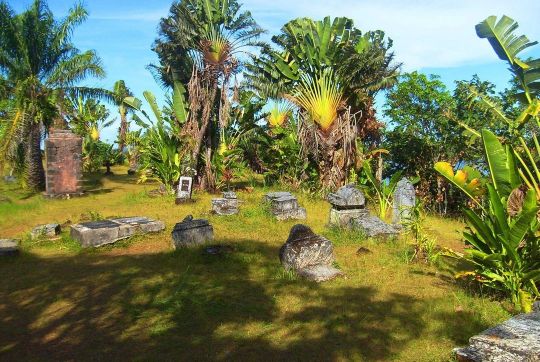
Visit he only pirate cemetery in the world that is located on an island near the capital city Ambodifotatra, on Ile Sainte Marie. The view over the bay and other islands is spectacular. https://buff.ly/3wi9kFm #pirates #cemetery #piratescemetery #ilesaintemarie #saintemarie #madagascar #nosyboraha #africa #indianocean #history https://www.instagram.com/p/ClTQ49bDU-l/?igshid=NGJjMDIxMWI=
#pirates#cemetery#piratescemetery#ilesaintemarie#saintemarie#madagascar#nosyboraha#africa#indianocean#history
1 note
·
View note
Text

"Oriental Warrior", also called "Barbary Pirate" by Pier Francesco Mola
Depicting Jan Janszoon van Haarlem, commonly known as Reis Mourad the Younger
#oriental#warrior#barbary corsairs#barbary coast#barbary pirates#pirate#pirates#north africa#mediterranean#history#art#pier francesco mola#jan janszoon#reis mourad the younger#ottoman#salé rovers#dutch#algeria#morocco#islam
56 notes
·
View notes
Text
AFRICA: CAF Confederation Cup Orlando Pirates 17:00 Al Ahly Tripoli
AFRICA: CAF Confederation Cup Orlando Pirates 17:00 Al Ahly Tripoli
Football » 15.05.2022 »
AFRICA: CAF Confederation Cup
Orlando Pirates 17:00 Al Ahly Tripoli
LIVE STREAM LINKS
FIXTURES, TOP PLAYERS & TEAM OF THE WEEK
Google Blogspot
Word Press
DISCLAIMER:
FOOTBALLLoversWEB does not host, control or upload any streams and/or media files. We are simply a database of embeded streams and this files are available throughout the internet. Please contact…

View On WordPress
0 notes
Text
annoying chronomancer who keeps dropping references in casual conversation to shit you don't understand. when asked about it, it turns out it's a movie that won't come out for 400 years and not in this universe anyway. when you can bend time and multiversal space to your will, pirating interdimensional anachronistic cable is trivial, so you end up consuming a lot of media that no one else will have seen or heard or felt or tasted.
You go over to their house for a party and they've got some other chronomancers over and they're all watching a sranga (it's like anime, but from quellistan (which is off the coast of west africa, just not in this timeline)) and it's from 1472 (Yeah that timeline invented animation real early!) and all the subtitles are in binary, but instead of 1 and 0 they're using 4 and 8? also they say some of the highlights on the characters can't be really enjoyed unless you can see ultraviolet. don't worry, by 2076 everyone will have that gene therapy to widen the range of their personal visual spectrum.
chronomancers are such jerks. Anyway the whole point of this is that even though this happened back in 1963, your chronomancer "friend" complains about that "ideas are bulletproof" speech from V for Vendetta. That's why they got one of their magical pistol buds to help them out, and she invented an Armor-Piercing Anti-Ideological Rifle. You ask why they would do this, and they said they were just so tired of everywhere playing the same 5 songs by The Silver Jimmies. You say you've never heard that band, are they from the future? No, they formed in 1958, and became the #1 best selling musical artist in 27 countries. You ask what timeline, and they say this one. At least, until they got their new rifle.
again, chronomancers can be jerks.
845 notes
·
View notes
Text
pertinent to nothing ( well, pertinent to being granted patriarchal power and choosing to either reject the standard of oppression or to continue the norm of your peers and predecessors ) but i was thinking about the moment when jack frees the slaves and how that’s not ... an uncomplicated moment of goodness ? in the way i feel it’s usually interpreted ? he agrees to haul them as cargo, with every intention of delivering them to the plantation, for the price of a ship ( “What sort of a man trades a man’s life for a ship?” ) and its only really when he can’t ignore what he’s done and it inhibits his own comfort –– the wench sailing differently, the smell of human bodies, the sound of the screams –– that he reconsiders. two men died on the voyage and there’s no indication that he improved their conditions or released them from their chains even after he decided to sail to kerma. and being taken to kerma likely offers them a better future than taking them back to west africa, or the caribbean, but ... why not allow each individual whatever freedom they wanted for themselves ? why not offer them the chance to join his future crew, if they so wished, where their rights will probably be more substantial than living under monarchical rule ? being taken to zezura is literally to trap them on a small island from which they are unable to sail away, in a culture frozen in time that is not their own, with a different language ... of course amenirdis and shabako promise to be good leaders who themselves have dealt with the experience of being slaves, but i simply feel that there was more to this than ‘jack did the right thing and this proves he’s a good man'
#idk i just feel like jack doesn't really treat them as human beings. he decides to dump them off at kerma because ... the zezurans came from#africa a few centuries ago and amenirdis is black ?#she's abolishing slavery but over time so zezura is still steeped in a culture of enslavement presently#something about it always reads to me like jack was looking for a reason to steal the ship and go pirate and these people just happened to#be his excuse#he never even spoke to any of them that i remember. or told them what was happening to them. like it just feels ... like of all the ways to#do a good thing (freeing people that are enslaved) he only did it in a way that could benefit himself and not inconvenience him#which. it's still a good act but.... complicated.#✘; I HAVE SEVENTY TWO EXAMS AND I HAVE NOT STUDIED FOR ONE ( ooc )
6 notes
·
View notes